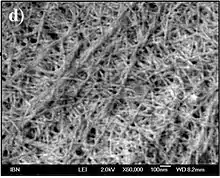Hydrogel dressing
Hydrogel dressings use a hydrogel pad in contact with the wound. The gel is mostly water, in a hydrophilic polymer matrix. They are designed to keep the wound slightly moist, releasing water or absorbing exudate. In a slightly moist environment, rodent skin heals faster than in a dry environment, from both cuts and partial-thickness burns.[1][2] There exists little evidence comparing hydrogel dressing to other advanced dressings in humans.[3]

A short-peptide-based hydrogel matrix, capable of holding about one hundred times its own weight in water. The thickness of the fibers is on the order of tens of nm, mimicking the fibrous microenvironment found in the extracellular matrix. FESEM image.

An entirely transparent adhesive bandage, with a transparent hydrogel pad and adhesive waterproof plastic film (removable backing is blue and white).
Polymers used in hydrogels include chitosan, dextran, alginate/gelatin and collagen/glycosaminoglycan. Other materials include custom polypeptides, and blends such as chitosan/sodium alginate/poly(vinyl acetate).[1]
References
- Seow, Wei Yang; Salgado, Giorgiana; Lane, E. Birgitte; Hauser, Charlotte A. E. (2016-09-07). "Transparent crosslinked ultrashort peptide hydrogel dressing with high shape-fidelity accelerates healing of full-thickness excision wounds". Scientific Reports. 6: 32670. Bibcode:2016NatSR...632670S. doi:10.1038/srep32670. ISSN 2045-2322. PMC 5013444. PMID 27600999.
- Loo, Yihua; Wong, Yong-Chiat; Cai, Elijah Z.; Ang, Chuan-Han; Raju, Ashvin; Lakshmanan, Anupama; Koh, Alvin G.; Zhou, Hui J.; Lim, Thiam-Chye; Moochhala, Shabbir M.; Hauser, Charlotte A.E. (June 2014). "Ultrashort peptide nanofibrous hydrogels for the acceleration of healing of burn wounds". Biomaterials. 35 (17): 4805–4814. doi:10.1016/j.biomaterials.2014.02.047. ISSN 0142-9612. PMID 24636214.
- Dumville, Jo C; O'Meara, Susan; Deshpande, Sohan; Speak, Katharine (2013-07-12). "Hydrogel dressings for healing diabetic foot ulcers". Cochrane Database of Systematic Reviews. Chichester, UK: John Wiley & Sons. pp. CD009101. doi:10.1002/14651858.CD009101.pub3. PMC 6486218. PMID 23846869.
This article is issued from Wikipedia. The text is licensed under Creative Commons - Attribution - Sharealike. Additional terms may apply for the media files.